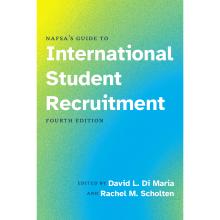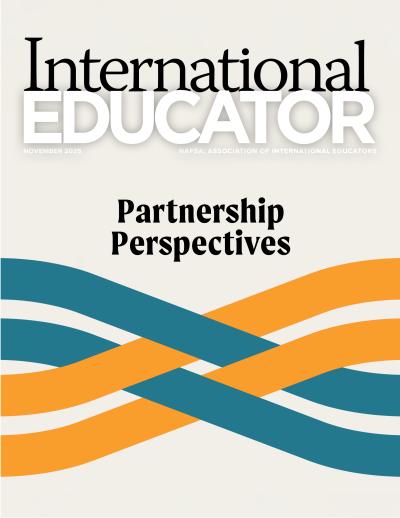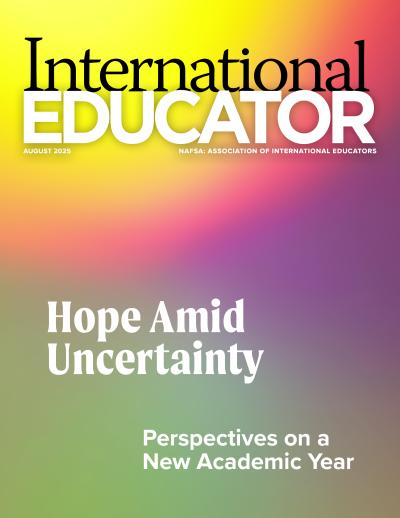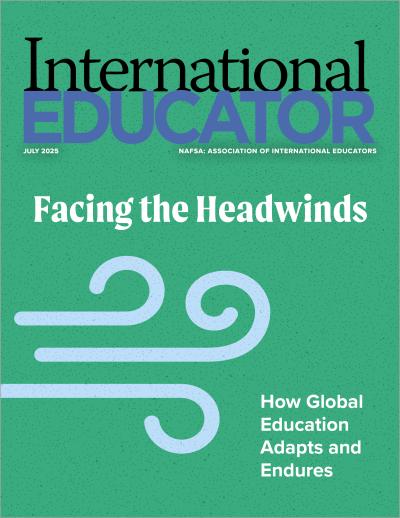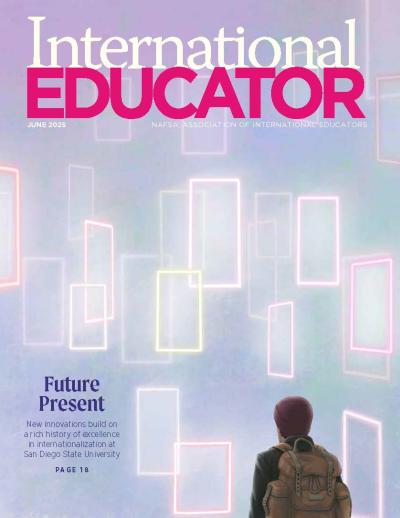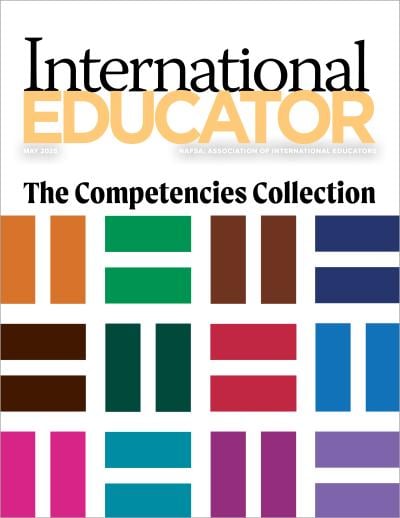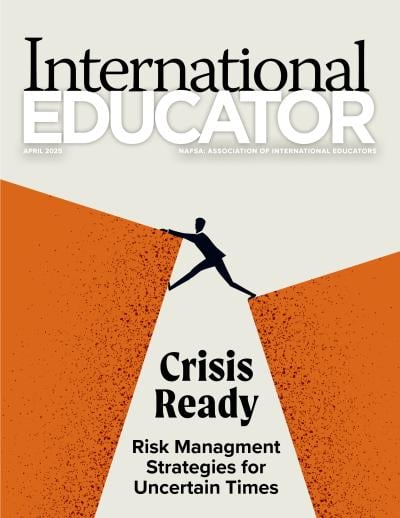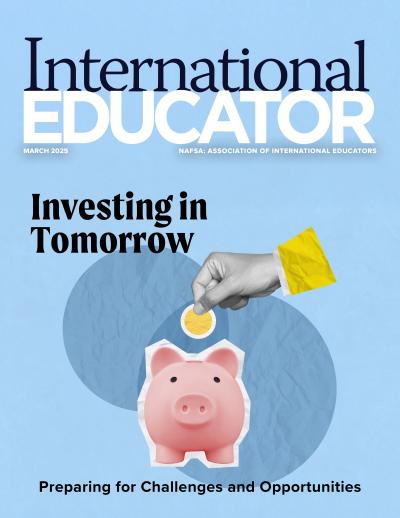Harnessing Technology in International Student Recruitment

Editor’s note: The following is an excerpt from the recently published NAFSA’s Guide to International Student Recruitment, Fourth Edition, co-edited by David L. Di Maria and Rachel M. Scholten. In an abbreviated version of the book’s introduction, Scholten puts the new edition of this important resource into context, including changes in the field of international education—and international enrollment management, in particular—since the previous edition was published in 2017.
One of the biggest changes has been in the area of technology in recruitment. The chapter on this topic, written by Kirsten L. Feddersen, covers the role of technology across all areas of enrollment management, including marketing, application and admission processes, post-acceptance procedures, artificial intelligence considerations, data-driven approaches, and recommendations for technology adoption.
Introduction
By Rachel M. Scholten
It is a truism in our field that the only constant is change. With the third edition of this book published in 2017 and changes seeming to occur at an exponential rate, it was clear that the time was ripe for an update to this resource. Since the previous edition, higher education has been affected by landmark events such as the “Varsity Blues” scandal; the Black Lives Matter movement; and the resolution of the legal cases Students for Fair Admissions v. President and Fellows of Harvard College and Students for Fair Admissions v. University of North Carolina, in which the Supreme Court struck down the use of race-conscious admissions. And, of course, the COVID-19 pandemic upended campuses and interrupted education and mobility the world over.
COVID-19 loosened the grip of standardized entrance exams in the United States but had different consequences in the other “Big Four” English-speaking destination countries: Australia, Canada, and the United Kingdom. Prior to the pandemic, these countries benefited from large numbers of international students, who made up between 22 and 31 percent of their total higher education enrollments, according to the Institute of International Education’s Project Atlas (2020). Intent on overcoming the financial deficits resulting from COVID-19—in particular, the loss of international student revenues during that time—these countries overenrolled international students without the institutional or local supports needed to accommodate the influx resulting from the pent-up demand of those unable to study abroad during lockdowns and border closures.
In a time of escalating authoritarianism and isolationism, international education is an urgent need. We must meet this moment, and our work must continue. This book is a tool to help us do just that.
The outcome of this overenrollment was that international populations rose as a percentage of total tertiary enrollments to 27 percent in the United Kingdom, 31 percent in Australia, and an astonishing 39 percent in Canada, according to the 2024 Project Atlas data release (Project Atlas 2024). This resulted in a backlash in each of these destinations, which saw the scapegoating of international students for housing shortages and unemployment and a rash of new government policies aimed at severely limiting future international enrollments. With international enrollments making up only a modest 6 percent of total college and university students in the United States as of 2024 (Project Atlas 2024), some in the field have theorized that the combination of these policies in competitor countries and capacity on U.S. campuses could result in an unprecedented boom in international enrollments in the United States. However, that prediction was made before the second Trump administration began.
Work on this book began before the 2024 presidential election. Thus, while there will undoubtedly be impacts on international student recruitment due to the Trump administration, it is outside the purview of this edition to analyze the consequences of the many devastating legal reinterpretations and policy changes targeting higher education institutions and international students since January 2025. International education has a unique ability to overcome ignorance with understanding, encourage critical thinking over indoctrination, and foster empathy rather than hate. In a time of escalating authoritarianism and isolationism, international education is an urgent need. We must meet this moment, and our work must continue. This book is a tool to help us do just that.
As educators working in international student recruitment, we have the duty and the honor to facilitate and advance this transformative process.
Readers will come to this book with varied experience levels and professional responsibilities, but we hope that the breadth of content offers constructive strategies and serves as a useful reference material to all readers. Higher education offers both incomparable access to a distillation of the most important contributions to our understanding of the world and the skills to build on and add to that knowledge. International education teaches us that the most noble use of such knowledge is the betterment of our global community. As educators working in international student recruitment, we have the duty and the honor to facilitate and advance this transformative process. Thank you for your support for this work. •
Technology
By Kirsten L. Feddersen
The mandate to recruit and enroll international students will be on the minds of most readers of this book. The international enrollment management (IEM) field is ever-evolving, and new challenges and opportunities continue to present themselves almost daily. Very few areas within higher education are as vulnerable to factors beyond their control as international student recruitment. Professionals are at the mercy of governments—overseas and at home—and pipelines can collapse or expand overnight due to currency fluctuations, political events, immigration policies, and various other factors. Targeting a global audience with different goals, values, languages, financial backgrounds, genders, and more adds a layer of complexity to institutions’ collective efforts to attract and serve international students.
Technology in International Enrollment Management
The impact of technology on IEM is by no means a new development. It takes on many forms, and the digitization of formerly analog processes, in particular, has seen tremendous growth. More seasoned professionals in the industry will remember the days when promotional materials only existed in hard copy; lead forms were completed by hand; application forms were paper based; and the admissions office had a physical folder for each applicant, which also eventually contained a hard copy of their I-20. While some may still rely on these tools and processes, the emergence of e-brochures, digital lead forms, online application systems, and digital I-20s, among many other services, has brought IEM well into the twenty-first century. Beyond digitization, the field has seen an explosion of technological advances that can assist institutions and prospective students with almost any aspect of the pre-enrollment journey. In a field that has leaned heavily on international recruitment travel and establishing a personal (in-person) connection with prospects and partners, the proliferation of technological alternatives may enable institutions to achieve their goals in a more cost-effective, efficient, and scalable way and may even help them tap into previously unexplored markets without necessarily making the “tried and true” methods obsolete.
So what exactly are these technological advances and solutions, and how can they help institutions reach their goals? The following technological advances and solutions are by no means an exhaustive list but include some of the more crucial and notable technological advancements that affect the daily lives of IEM professionals (organized by stage):
Recruitment and Marketing: Finding and Connecting with Prospective Students
The nature of “armchair recruitment,” which Canty (2009, 92) defines as “cost effective recruiting that is conducted by means of print publications and web-based communications, which are done without leaving one’s desk,” has changed dramatically over the last 20 years, and most notably since the global COVID-19 pandemic of 2020, where—for a while—it was the only option for engaging with prospective students while the world was on lockdown. While recruitment travel has not become obsolete, as some might have expected after the pandemic, it is now competing with various armchair recruitment and marketing options to help find, engage, and enroll international students. Technological marketing and recruitment services come in all shapes and sizes and include global student choice platforms; digital marketing services for brand awareness, social media engagement, and lead generation; student ambassador platforms for peer-to-peer engagement; recruitment agents without a physical office; virtual campus tours and VR/AR-powered campus showcases; online recruitment event platforms; virtual student counseling services; global student interest data to help profile prospects; and—more recently—chatbots powered by artificial intelligence (AI) to answer questions from prospective students as well as technology that matches them with universities. All of these options, and many more, aim to pique prospects’ interest and ultimately encourage them to apply.
Application and Admission: Encouraging Prospects to Apply
Once prospects have been identified and added to the institution’s digital ecosystem, they will ideally start and submit an application with an aim to be admitted to the institution. Through technological advances, the previously analog and manual admissions process, which included mailing the application form to the admissions office, has changed drastically, and the time required to start, complete, and submit an application has been significantly reduced. Questions regarding the application process can typically be answered within a day or two (or sometimes immediately for those who have well-trained AI chatbots or live chat with student advisers); once the submit button has been clicked, the application form has already been received by the institution. Technology also plays a role in the subsequent steps in the admissions process. Most institutions accept proficiency tests completed on a computer in a lab or at home—in some cases, with AI performing most of the assessment—and many will (preliminarily) accept transcripts submitted digitally. Some rely on AI to read and summarize/evaluate admissions documents, and the admissions and/or customer relationship management (CRM) system typically plays a critical role in ensuring that the process is completed in a timely, accurate, and compliant manner. Technology has penetrated the world of admissions from all angles and greatly reduced (but not entirely eliminated) the need for physical documents and folders.
Post-Acceptance: Prospect Has Been Admitted
Once accepted, admitted prospects are also shepherded through a number of steps with the ultimate goal of welcoming them to campus. While these processes are hardly automatic and still require human management, the technology involved in this step of the journey includes systems for universities to manage immigration processes, loan providers who can help with financing without the need for a visit to a physical bank, financial verification services that operate digitally, virtual visa application processes (although when this chapter was written the United States still requires F-1 visa applicants to appear for an in-person interview), and much more. Some institutions utilize online engagement to encourage admitted prospects to commit to their institution and may offer virtual prearrival sessions, “office” hours through commonly used social media platforms or channels, incentives through scholarships that are tied to a social media “takeover” once students have enrolled and more.
The previous examples constitute a small subsection of options available and simply serve to highlight the extent to which technology has permeated the daily lives of IEM professionals. Technology, for all of its advantages, does, however, also carry some risks that need to be considered. With the entry of AI into the world of IEM, the reliance on technology to carry out formerly human-driven tasks, the need for accurate data, and much more, it is necessary to take a step back and look at this in the greater context of what institutions are looking to accomplish.
Before addressing AI, however, it is important to consider both the opportunities and challenges posed by the ongoing technology revolution in the IEM and recruitment space. Institutions will continue to have to make decisions about technology for the foreseeable future and beyond. While some institutions take a conservative approach to adopting new technologies, some will opt to be early adopters to gain a competitive advantage, which begs the question: When is the “right” time to adopt a new technology? According to Gartner (2023), a well-known consulting company in the technology space, the emergence of new technologies typically follows what they refer to as the Hype Cycle. The Hype Cycle consists of five stages:
- Innovation Trigger: A potential technology breakthrough kicks things off. Early proof-of-concept stories and media interest trigger significant publicity. Often no usable products exist and commercial viability is unproven.
- Peak of Inflated Expectations: Early publicity produces a number of success stories—often accompanied by scores of failures. Some companies take action; many do not.
- Trough of Disillusionment: Interest wanes as experiments and implementations fail to deliver. Producers of the technology shake out or fail. Investments continue only if the surviving providers improve their products to the satisfaction of early adopters.
- Slope of Enlightenment: More instances of how the technology can benefit the enterprise start to crystallize and become more widely understood. Second- and third-generation products appear from technology providers. More enterprises fund pilots; conservative companies remain cautious.
- Plateau of Productivity: Mainstream adoption starts to take off. Criteria for assessing provider viability are more clearly defined. The technology’s broad market applicability and relevance are clearly paying off (Gartner 2023).
The cycle illustrates the challenges entailed in the decision about whether or not to adopt an emerging technology. If the adoption happens while the technology is at the Innovation Trigger stage, there is a risk that the product will fail during the Trough of Disillusionment stage. However, if the product has long-term staying power and reaches the Plateau of Productivity, early adopters may have the advantage of already having implemented the technology and trained their staff. Conversely, if the technology drops off before reaching this stage, early adopters may find themselves back where they started but with fewer resources and less capital to invest in replacing what they lost. In addition to the possibility of technology solutions being reshaped, replaced, or phased out before they reach the Plateau of Productivity, there is an inherent risk that companies who lean heavily on some of these technologies for their core offerings or whose proposed service models do not meet expectations for delivery are simply phased out. Start-ups, in particular, are at risk of ending up in what Verne Harnish (2014) refers to as the Valley of Death in his book Scaling Up. The Valley of Death refers to the possibility of failure between growth milestones for start-ups that are not adequately prepared for growth, which is often tied to a lack of changes in infrastructure, staffing, talent, systems, and similar. For each revenue growth milestone, the company’s chances of survival decrease, and ultimately, very few end up becoming million- or billion-dollar companies. Tying this back to the international student recruitment field, this is important to keep in mind when considering whether or how soon to adopt a new technology. The rule of thumb is not to consistently be conservative but rather to ask critical questions, do research, and consider both pros and cons before deciding whether or not to be an early adopter.
Artificial Intelligence
The rise of AI in the media and in our lives has become the proverbial snowball that we are watching as it is growing its way down the mountain, and generative AI, in particular, has recently taken center stage by virtue of tools like ChatGPT, among others. AI provides tremendous opportunities for scalability, access, analysis, consistency, and a slew of other functions and has also made its entry into higher education and international student recruitment. Institutions and agents alike now have the option to let AI handle certain aspects of communication with prospective students through chatbots, read and summarize applications, and much more. With its popularity and potential, however, comes some caveats and risks that need to be addressed, particularly as it relates to generative AI. A 2023 article in the Dutch journalism platform De Correspondent provides the example of a lawyer who presents a fictitious court case to a judge to support a case he is arguing only to learn that the information ChatGPT first provided and since confirmed the validity of was, in fact, entirely made up (Weerts 2023). According to the article, ChatGPT “works less like a search engine and more like the autocomplete feature on your phone,” and explains that ChatGPT bases its answers on statistical patterns rather than an actual database. This begs the question of not only how to ensure that AI solutions are sufficiently reliable to handle recruitment-related tasks without human involvement but also how institutions can counteract or get ahead of false information provided directly to students by AI tools such as ChatGPT. Certainly providing clear, accurate, and consistent information to prospective international students on the institution’s website and through direct outreach would be a good start as it relates to the latter above. As for the former, RNL, in a 2024 article argues that “AI has no inherent ability to know when it is telling you the truth, so it will produce results that it predicts are the most likely response according to its existing algorithms.” While, as mentioned earlier, some types of AI have gone through significant development and improvement, institutions should ask a few critical questions before venturing into using AI for recruitment purposes:
- How mature and reliable is the type of AI considered?
- What are the possible implications if AI makes a mistake?
- What are the risks of misuse?
- Does the use of AI in the admissions process positively or negatively affect students’ perception—and are they willing to trust AI?
- Which processes and decisions is the institution willing to entrust AI with?
- Are the solutions free of bias and inaccuracy? (RNL 2024)
- Do the solutions follow responsible AI principles? (RNL 2024)
- Are the solutions secure? (RNL 2024)
The questions are appropriate for the current state of AI, but new questions need to be raised as the field continues to develop. The critical recommendation here is to go into an AI implementation with eyes open and to ask critical questions.
Data
A former buzzword that has now become a common word in the daily vernacular of international student recruitment professionals is the notion of being data driven. The desire or mandate to use data to inform strategies, decisions, and processes is presumably fairly common for most institutions, and there appears to be widespread agreement that better data leads to better outcomes. But how is the desire to be data driven turned into action, and what is the impact to international recruitment outcomes? In 2023 and 2024, Studyportals conducted several data maturity surveys among higher education institutions in the United States and Canada. Participants were asked to rate their institution on the purpose and quality of their data, data sources and tools used, data culture, and the ultimate impact of using data. The results, which were subsequently discussed as a group with the participating institutions, pointed to some interesting limitations in higher education institution’s quest to be data driven. In addition to significant usage of publicly available datasets, institutions rely quite strongly on internal datasets whose quality and accuracy is often in question and not necessarily quantifiable or consolidated. Data collection is often done with a domestic audience in mind, and there is limited sophistication when it comes to data management tools, as evidenced by responses consistently pointing to “spreadsheets” as one of their most frequently used tools. Another significant shortcoming was the frequent absence of analytics staff embedded within enrollment management units and lack of training on using data for staff who are often expected to be data driven. Finally, institutions rated themselves higher when asked whether leadership invests resources/budget in data and acts according to data-based recommendations.
Looking at the above points collectively, it may explain why some institutions are challenged to be fully data driven in their efforts to recruit international students. According to the above, institutions operate with a limited variety of data sources that may also not be entirely consolidated, accurate, or recent, and they are using spreadsheets to manage and visualize the data. Additionally, without adequate training or sufficient analytics staff embedded within individual departments, they are expected to use data for recruitment planning purposes without proper training and, presumably, held responsible for the subsequent outcomes, that is, when enrollment targets are not met. While the survey findings indicate that leadership does well in acting according to data-based recommendations, it raises a question about the validity or appropriateness of the recommended actions considering the limitations outlined above.
Recommendations for Becoming Highly Data Driven
Institutional leadership should aim to ensure the following when collecting and using data:
- Data are collected adequately and appropriately across the organization to ensure international recruitment teams have the necessary data to make informed decisions about their strategic initiatives, target countries and budgets. All recruitment and admissions units, whether their focus is domestic or international students, should have access to high-quality data to help with decision-making.
- The technology infrastructure supports collection of high-quality data, and there is a high level of consistency in how data is entered into systems (data scientists commonly refers to this as GIGO—garbage in, garbage out).
- All units who are asked to make data-informed decisions are adequately staffed or trained for using data effectively.
- Recruitment staff have the necessary tools to help them work efficiently with data, thereby also reducing the risk of using their budgets for initiatives that do not produce the expected results.
- Data are sufficiently cleaned, validated, and analyzed before making critical decisions to inform recruitment strategies.
Recruitment professionals should aim to:
- Look at data through a critical lens. If something looks off, investigate. It may be a data quality issue.
- Ask questions about definitions. Definitions of “international,” “enrolled,” and so on may vary across business units, and “country” may not always refer to citizenship.
- Ask for recruitment-specific reports. The institutional research/analytics unit can build reports in Tableau, PowerBI, or similar that specifically address recruitment needs.
- Dig for underutilized data sources. Consider whether any of the other systems used by the institution might contain useful data (marketing automation tool, SEVIS tool, Google Analytics, or similar).
- Learn how to create pivot tables in Excel. If Excel is still a critical tool for the business unit, this will help run basic analytics on raw data.
Recommendations and Considerations for Using Technology for Recruitment
So where does that leave the IEM and recruitment professionals and university leadership responsible for ensuring their institution’s continued existence and growth? Without knowing exactly what the future looks like in terms of the various technologies, there is an inherent risk both in deciding to adopt a new technology and deciding not to. Each institution will likely have both detractors and promoters when it comes to technology solutions, and often there is no way of determining with absolute certainty whose opinion is the “right” one. Below are some initial considerations and questions that may be helpful in gauging whether an institution should or should not adopt a new technology for recruitment purposes (not a comprehensive list). Whether the institution is subscribing to a service, digitizing an analog process, partnering with a provider for technologically driven recruitment services, implementing a new technology system, or something different altogether, the word “technology” refers to any one of these solutions.
Financial Investment
- If there is an up-front investment, how does the risk involved in implementing the technology stack up against the size of the investment and the expected outcome?
- Is the provider asking for any exclusivity, and if so, what are the potential financial risks involved if they do not deliver?
Example: A university signs a costly long-term exclusive agreement for a solution that promises significant growth and, if successful, could make other recruitment efforts entirely obsolete, thereby allowing the institution to reduce future recruitment spending while increasing revenue. However, the technology provider was unprepared for growth, reached a Valley of Death, and ceased to exist. The institution has lost significant revenue and must invest in rebuilding its recruitment infrastructure and funnels.
- How much will need to be invested in the technology over time?
Staff Resources
- How exactly will recruitment staff and units benefit from implementing this technology? Are there any potential negative impacts, also within the institution’s larger context?
- Will the technology positively affect staff resources, bandwidth, and room for error (reduce manual steps, make processes more efficient, or similar)? Does the technology positively or negatively affect their bandwidth to carry out tasks critical to the business unit, including recruitment travel, timely follow-up on leads, and communication with students and recruitment partners?
Example: An institution implements an engagement platform that necessitates the involvement and effort of currently enrolled students, but the institution did not have a plan for how to identify, train, or manage this part of the process. Now the institution has to make significant investments in additional staff to ensure proper return on investment on the original investment, which negatively affects their recruitment budget and staff time.
- Will training be required, and if so, what does that look like in terms of cost, time, and expertise needed to deliver the training? Is training delivered by the provider, or, if not, can it easily be completed with existing in-house resources? Has buy-in from key stakeholders in the institution been secured to ensure widespread support during and after the implementation, including by those who will be using the system?
Existing Technology Infrastructure
- Does the technology “fit” with existing systems and processes? By adopting the technology, will the institution’s and business unit’s tech infrastructure become more or less complex? If the latter, is there a sufficient benefit from the adoption to justify this?
- Does it replace an existing system, and if so, what does that phase-out look like?
- Is the technology “broad” enough to benefit the institution in the broader sense, particularly given the highly decentralized nature of many institutions? Will it create unintended challenges anywhere in the greater institutional ecosystem?
Example: An institution decides to implement a new CRM system, but the stakeholders consulted during the design process primarily work with a domestic student population and do not have sufficient knowledge or understanding of the processes involved in recruiting and admitting international students. As a result, the new CRM system requires significant workarounds and manual processes for the recruitment team.
Desired Outcome
- Is it likely that the adoption of the technology will have the desired outcome? If the institution is looking for growth, does the technology eliminate obstacles currently standing in the way of growth?
- Does the technology help eliminate gaps in the current infrastructure or reduce the possibility of human errors or bandwidth issues?
Example: An institution has traditionally relied on one-to-one email outreach to prospective international students in their pipeline but decided to implement technology that sends automated outreach to prospects and applicants, thus (a) eliminating the risk that no outreach is initiated due to staff bandwidth issues or illness, and (b) freeing up recruitment and admissions staff to communicate personally with prospects during strategically significant times during the cycle or for other critical tasks.
- If the system is implemented to optimize efficiency within the institution, will this be the likely outcome for all business units involved or will some need to create workarounds to use the system effectively?
Time Frame for Success
- How long will the implementation take, and how quickly will the technology adoption have the desired impact?
- What is the optimal timing for the implementation? At which point in the recruitment and admissions cycle will it be the least disruptive for applicants and staff alike?
- If the implementation is a lengthy and comprehensive process and it happens during critical points in the cycle, how does that affect the staff’s ability to carry out their responsibilities?
- Is leadership aware of and in agreement with the expected timeline for the desired outcome?
Example: An IEM unit secures the necessary budget for a technology initiative that is expected to yield a 20 percent growth in enrollments. Leadership and IEM do not discuss the expected timeline during the budget conversation. When, a year after implementation, there is no notable growth in the number of enrollments, leadership decides not to allocate budget for the continuation of the project, unaware that the growth milestone was expected in year 3.
Is the Technology Tried and True?
- Is the technology solution tried and true? Has the technology itself and its claims been thoroughly tested by other units and international recruitment professionals?
- What are the potential risks for the institution in using this type of technology and provider? What are the risks to prospective students?
Example: An institution decides to implement an AI chatbot on its website with the expectation that it will increase engagement with prospective students and provide a better service experience through more immediate feedback. However, after implementation, most questions are posed by applicants who are looking for an update on their application, and the chatbot is typically unable to help, which causes frustration for the applicants, who perceive AI as being less trustworthy than humans.
- How experienced is the technology provider, and how long has the company delivered this type of solution or similar solutions? Does evidence exist that they can deliver the desired outcomes?
Ethics
- Is the technology solution responsible and ethical, and does it ultimately set students up for long-term success?
Example: An institution decides to adopt or accept a technology solution that eliminates a barrier for prospective students in the admissions process by making something “easier.” The goal is to increase the number of admitted and enrolled international students. After a few intakes, the institution starts to see a higher rate of poor academic performance among students who were admitted using the technology. It turns out that the imposed barrier was a necessary stopgap to eliminate less qualified students, who are now at risk of academic failure.
- Is the technology compliant with standing regulations, including internal compliance requirements for the institution?
- Has the technology scaled responsibly, or does the growth promised by the solution compromise the quality of the outcome?
- Is the solution aligned with the larger goals and ethical standards expected by the institution and best practices in the international higher education field? Is it aligned with NAFSA’s Statement of Ethical Principles (NAFSA 2019)?
Conclusion
The benefits of technology are immense, and in order for institutions to remain modern organizations and stay relevant, the adoption of new technologies is critical to their continued success. The benefits and risks associated with new technologies go hand in hand, and one does not exist without the other. Below are a few concluding thoughts and recommendations on how to approach technology options for recruitment purposes:
- Ask your peers in the field and prioritize feedback from those who have firsthand experience with the technology.
- Ask the technology company for references (and check them). If they are a start-up and do not have references, consider your options carefully.
- Consider the sophistication level of the institution’s technology infrastructure and what is required to make the technology adoption a success.
- Do a gut check. If something sounds too good to be true, it just might be.
- Avoid exclusive agreements as they tend to favor the party requesting the exclusivity. However, exclusivity could be (carefully) considered if it is mutual.
- Consider the downstream effects, including how this new technology affects workload and current technology infrastructure.
- Think about the impact on future students and whether this technology helps them (short term and long term).
- Approach AI with a healthy dose of skepticism, and consider which tasks it should be trusted to complete. Investigate how “mature” the AI option is (consider the Hype Cycle for AI).
- Remember that while being an early adopter can give you a competitive advantage, it also carries a risk.
Last, technology is here to stay. When created and applied responsibly, it carries tremendous potential for growth and modernization in all facets of IEM and international student recruitment—and, most importantly, for granting students the opportunity to build a better future for themselves. •
References
Canty, Bridget E. 2009. International Armchair Recruitment: Enhancing Your Assets with a Limited Budget. In International Students: Strengthening a Critical Resource, edited by Maureen S. Andrade and Norman W. Evans, 91–95. Lanham, MD: Roman & Littlefield Education.
Gartner. 2023. “Gartner Hype Cycle.” Gartner. Accessed April 10, 2025. https://www.gartner.com/en/research/methodologies/gartner-hype-cycle.
Gartner. n.d. “What’s New in Artificial Intelligence from the 2023 Gartner Hype Cycle.” Gartner. Accessed September 9, 2024. https://www.gartner.com/en/articles/what-s-new-in-artificial-intelligence-from-the-2023-gartner-hype-cycle.
Harnish, Verne. 2014. Scaling Up. Ashburn, VA: Gazelles, Inc.
ICEF Monitor. 2023. “Survey Reveals Students’ Views on AI in Study Search and Admissions.” ICEF Monitor. November 29, 2023. https://monitor.icef.com/2023/11/survey-reveals-students-views-on-ai-in-study-search-and-admissions.
Jenkins, Rebecca. 2024. “Artificial Intelligence for Higher Education: What It Is and What to Look Out For.” Education Insights (blog). July 7, 2024. https://www.ruffalonl.com/blog/artificial-intelligence/artificial-intelligence-for-higher-education-what-it-is-and-what-to-look-out-for.
NAFSA. 2019. NAFSA’s Statement of Ethical Principles. Washington, D.C.: NAFSA: Association of International Educators. https://www.nafsa.org/about-us/about-nafsa/nafsas-statement-ethical-principles.
Weerts, Hilde. 2023. “ChatGPT is een knap staaltje AI, maar betrouwbaar wordt het nooit [ChatGPT is a good example of AI, but it never becomes reliable].” De Correspondent. Updated November 7, 2023. https://decorrespondent.nl/14926/chatgpt-is-een-knap-staaltje-ai-maar-betrouwbaar-wordt-het-nooit/ce34e7de-8c49-036c-0d21-86cebdde3743.
About International Educator
International Educator is NAFSA’s flagship publication and has been published continually since 1990. As a record of the association and the field of international education, IE includes articles on a variety of topics, trends, and issues facing NAFSA members and their work.
From in-depth features to interviews with thought leaders and columns tailored to NAFSA’s knowledge communities, IE provides must-read context and analysis to those working around the globe to advance international education and exchange.
About NAFSA
NAFSA: Association of International Educators is the world's largest nonprofit association dedicated to international education and exchange. NAFSA serves the needs of more than 10,000 members and international educators worldwide at more than 3,500 institutions, in over 150 countries.
NAFSA membership provides you with unmatched access to best-in-class programs, critical updates, and resources to professionalize your practice. Members gain unrivaled opportunities to partner with experienced international education leaders.


